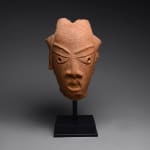Nok Terracotta Head of a Woman, 200 BCE - 200 CE
Terracotta
height 24.1 cm
height 9 1/2 in
height 9 1/2 in
SP.574
Further images
Comparatively little is known of the Nok culture, which is defined largely on the basis of its superb terracotta artworks. Flourishing between 900 BC and 200 AD, the Nok style...
Comparatively little is known of the Nok culture, which is defined largely on the basis of its superb terracotta artworks. Flourishing between 900 BC and 200 AD, the Nok style is in fact an agglomeration of similar traditions that flourished in western and central Nigeria. While there are different stylistic categories, these have little social significance as finds of in-situ Nok material culture are almost unheard-of. Stray archaeological discoveries have confirmed that the Nok culture is in fact a myth – the Nok is a tradition, a style of manufacture that was adopted by different Iron-Age agriculturally- based communities that in fact had widely varying cultures in all other respects. What does unite the trends, however, is a series of outstanding ceramic sculptures, which constitute the most sophisticated and formalised early African artistic tradition outside Egypt. It should be noted that the sophistication of these terracottas makes some scholars believe that they sprang from a hitherto undiscovered ceramic tradition. Technically, they are very unusual because of the manner in which coiled and subtractive sculpting methods were used to capture likenesses. Aesthetically, they are both naturalistic and expressionist, with highly distinctive elongated forms, triangular eyes, pierced pupils/nostrils and elaborate hairstyles. Substyles of the Nok tradition include the Classical Jemaa Style, the Katsina Ala Style (elongated heads) and the Sokoto Style (elongated monobrow foreheads, lending a severe expression to the face) and random variants such as the Herm Statues of Kuchamfa (simplified cylindrical figures topped with normal heads) and the “standard” three-dimensional standing figures, which subscribe to the Jemaa style. The function of the art is unclear, although the care with which they are executed has led some to claim they represent nobility, perhaps ancestors to which obeisance and sacrifices were offered. The current example is an isolated large ceramic head. The eyes are drilled under separated brows, so the piece cannot be from the Sokoto group. The general proportions of the face are reminiscent of the Katsina group, but it does not have the characteristic facial elongation for which this group is also noted. The piece is therefore closest to the classical Jemaa style, which is perhaps the most instantly recognisable style in the Nok artistic pantheon. The face appears to be male, with high, straight brows over triangular eyes with pierced pupils. The forehead is high and domed, the hair comprising a series of distinct bunches with – unusually – an inverted fringe rising up to meet the body of the hair at the nape of the neck. The nose is trilobate, with defined nasal septum and nostrils clearly marked, while the mouth is fine-lipped and flared. The general proportions of the face, especially the nose and cheeks, are the main reason why some authorities have claimed that the Nok are linked in some way with the Bantu expansion that characterises the facial traits of most Sub-Saharan Africans. As one of the most famous artistic foundations in African art history, Nok terracottas are something that no serious collection can afford to be without.







